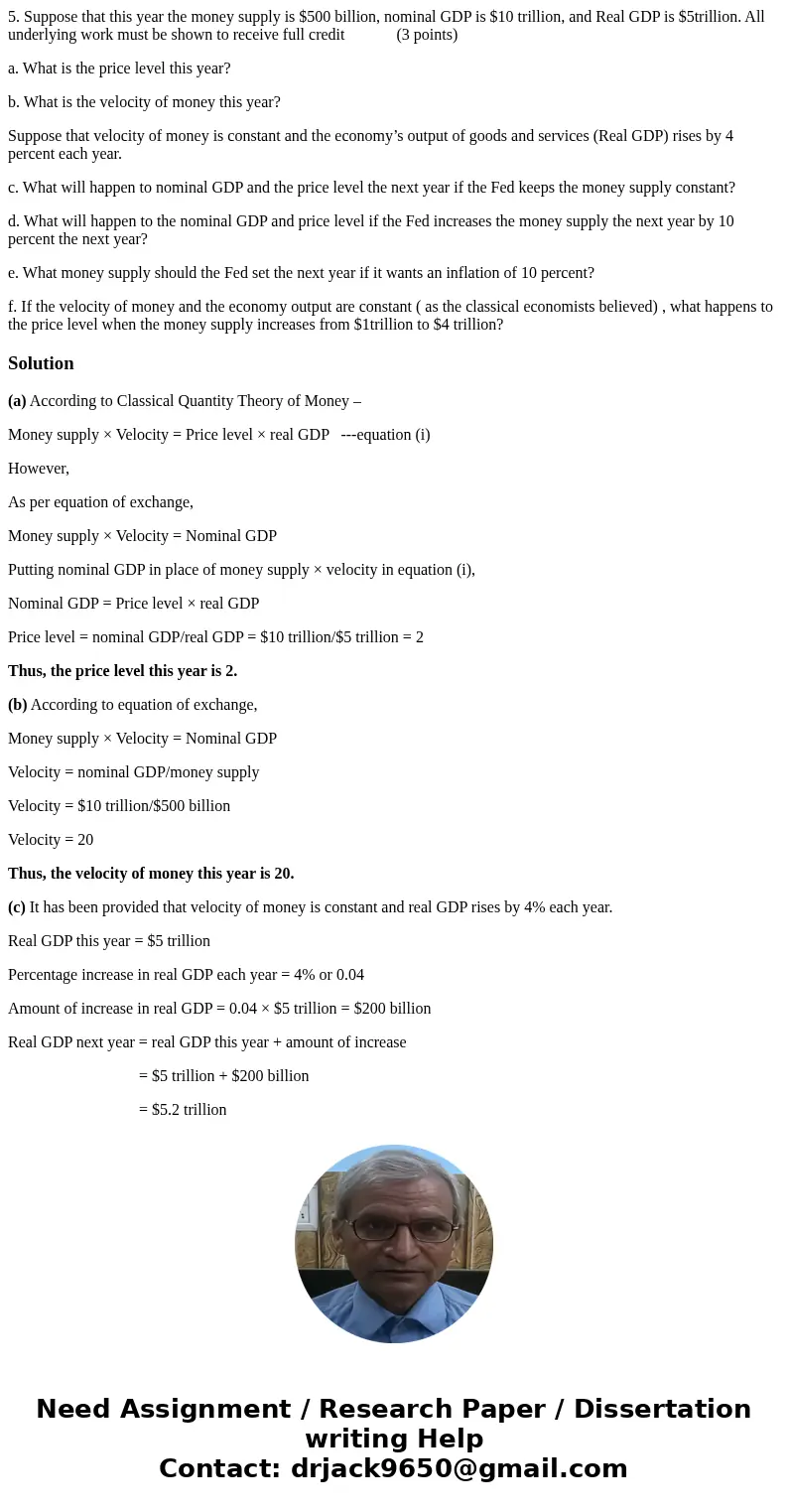5 Suppose that this year the money supply is 500 billion nom
5. Suppose that this year the money supply is $500 billion, nominal GDP is $10 trillion, and Real GDP is $5trillion. All underlying work must be shown to receive full credit (3 points)
a. What is the price level this year?
b. What is the velocity of money this year?
Suppose that velocity of money is constant and the economy’s output of goods and services (Real GDP) rises by 4 percent each year.
c. What will happen to nominal GDP and the price level the next year if the Fed keeps the money supply constant?
d. What will happen to the nominal GDP and price level if the Fed increases the money supply the next year by 10 percent the next year?
e. What money supply should the Fed set the next year if it wants an inflation of 10 percent?
f. If the velocity of money and the economy output are constant ( as the classical economists believed) , what happens to the price level when the money supply increases from $1trillion to $4 trillion?
Solution
(a) According to Classical Quantity Theory of Money –
Money supply × Velocity = Price level × real GDP ---equation (i)
However,
As per equation of exchange,
Money supply × Velocity = Nominal GDP
Putting nominal GDP in place of money supply × velocity in equation (i),
Nominal GDP = Price level × real GDP
Price level = nominal GDP/real GDP = $10 trillion/$5 trillion = 2
Thus, the price level this year is 2.
(b) According to equation of exchange,
Money supply × Velocity = Nominal GDP
Velocity = nominal GDP/money supply
Velocity = $10 trillion/$500 billion
Velocity = 20
Thus, the velocity of money this year is 20.
(c) It has been provided that velocity of money is constant and real GDP rises by 4% each year.
Real GDP this year = $5 trillion
Percentage increase in real GDP each year = 4% or 0.04
Amount of increase in real GDP = 0.04 × $5 trillion = $200 billion
Real GDP next year = real GDP this year + amount of increase
= $5 trillion + $200 billion
= $5.2 trillion
It has also been stated that Fed has kept the money supply constant next year.
Calculate price level next year –
According to Classical Quantity Theory of Money –
Money supply × Velocity = Price level × real GDP
Price level = (Money Supply × Velocity)/real GDP
Price level = ($500 billion × 20)/$5.2 trillion
Price level = 1.92
The price level next year is 1.92. This means that, next year, price level will decline by 0.08 with respect to current year.
Calculate nominal GDP next year –
According to equation of exchange,
Money supply × Velocity = Nominal GDP
Both money supply and velocity are constant next year.
Nominal GDP = $500 billion × 20
= $10 trillion
Thus, nominal GDP next year is $10 trillion. This means, next year, there is no change in nominal GDP with respect to current year.
(d) It has been provided that velocity of money is constant and real GDP rises by 4% each year.
Real GDP this year = $5 trillion
Percentage increase in real GDP each year = 4% or 0.04
Amount of increase in real GDP = 0.04 × $5 trillion = $200 billion
Real GDP next year = real GDP this year + amount of increase
= $5 trillion + $200 billion
= $5.2 trillion
It has also been stated that Fed has increased the money supply by 10 percent next year.
Money supply this year = $500 billion
Percentage increase in money supply = 10% or 0.10
Amount of increase in money supply = $500 billion × 0.10 = $50 billion
Money supply next year = Money supply this year + Amount of increase in money supply
Money supply next year = $500 billion + $50 billion = $550 billion
Calculate price level next year –
According to Classical Quantity Theory of Money –
Money supply × Velocity = Price level × real GDP
Price level = (Money Supply × Velocity)/real GDP
Price level = ($550 billion × 20)/$5.2 trillion
Price level = 2.11
The price level next year is 2.11. This means that, next year, price level will rise by 0.11 with respect to current year.
Calculate nominal GDP next year –
According to equation of exchange,
Money supply × Velocity = Nominal GDP
Nominal GDP = $550 billion × 20
= $11 trillion
Thus, nominal GDP next year is $11 trillion. This means, next year, nominal GDP will increase by $1 trillion with respect to current year.



 Homework Sourse
Homework Sourse